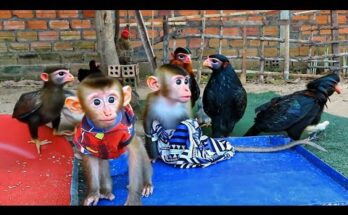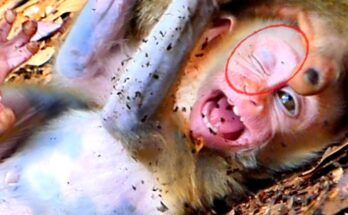
There’s something irresistibly heartwarming about seeing a newborn creature explore the world for the first time—and when that creature is a baby capuchin monkey, the cuteness is off the charts. Just a few weeks old, with wide eyes, tiny fingers, and a playful spirit, this baby capuchin is already stealing hearts.
Capuchin monkeys are known for their intelligence, curiosity, and expressive faces. Native to Central and South America, they live in complex social groups where grooming, communication, and cooperation are key to survival. But in the early days of life, everything for a baby capuchin revolves around one thing: bonding.
At just a few weeks old, a baby capuchin still clings tightly to its mother’s back or belly. This physical closeness is crucial—not just for safety, but for warmth, learning, and trust. From this close-up view, the baby begins to observe the troop, watching how the older monkeys interact, how food is found, and how social rules are followed.
What makes baby capuchins so charming isn’t just their appearance—though with their oversized eyes, fuzzy coats, and delicate limbs, they look like living plush toys. It’s their personalities beginning to emerge even at such a young age. A few playful swipes at leaves, a curious tilt of the head, or an attempt to mimic an adult’s movement show just how quickly they begin to learn.
In these early weeks, the baby depends entirely on its mother and the support of the group. Other members of the troop, including older siblings or “aunties,” may help care for the baby, offering gentle grooming or even carrying it for short periods. These shared responsibilities help the baby develop social bonds that will last a lifetime.
Feeding during this stage is mostly through nursing, but by a few weeks old, the baby may start mouthing bits of fruit or leaves—testing the waters of solid food. Watching a baby capuchin try to peel a banana or bite a piece of mango for the first time is both comical and touching, as they struggle with coordination but persist with determination.
The way the troop protects and interacts with the baby is a testament to the emotional depth of capuchin communities. They are not only aware of the baby’s presence but often gather around to observe or groom the mother and child. It’s a shared celebration of new life, and the whole group seems to recognize the importance of this tiny member.
As the baby grows, its playful nature blossoms. Soon, it will be chasing butterflies, tumbling with other young monkeys, and testing its independence. But for now, in these earliest weeks, it is a soft, fragile symbol of hope and wonder in the jungle.
In the quiet moments of sunlight streaming through the trees, as the baby nestles against its mother or gazes in awe at the world around it, it’s hard not to smile. This little capuchin reminds us of the simple magic of beginnings—and the universal joy of new life.


